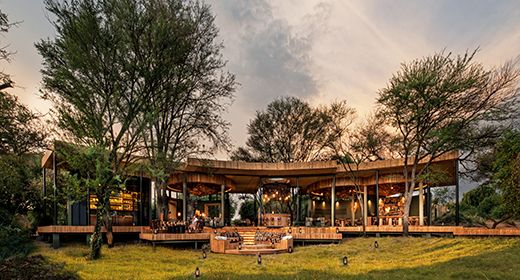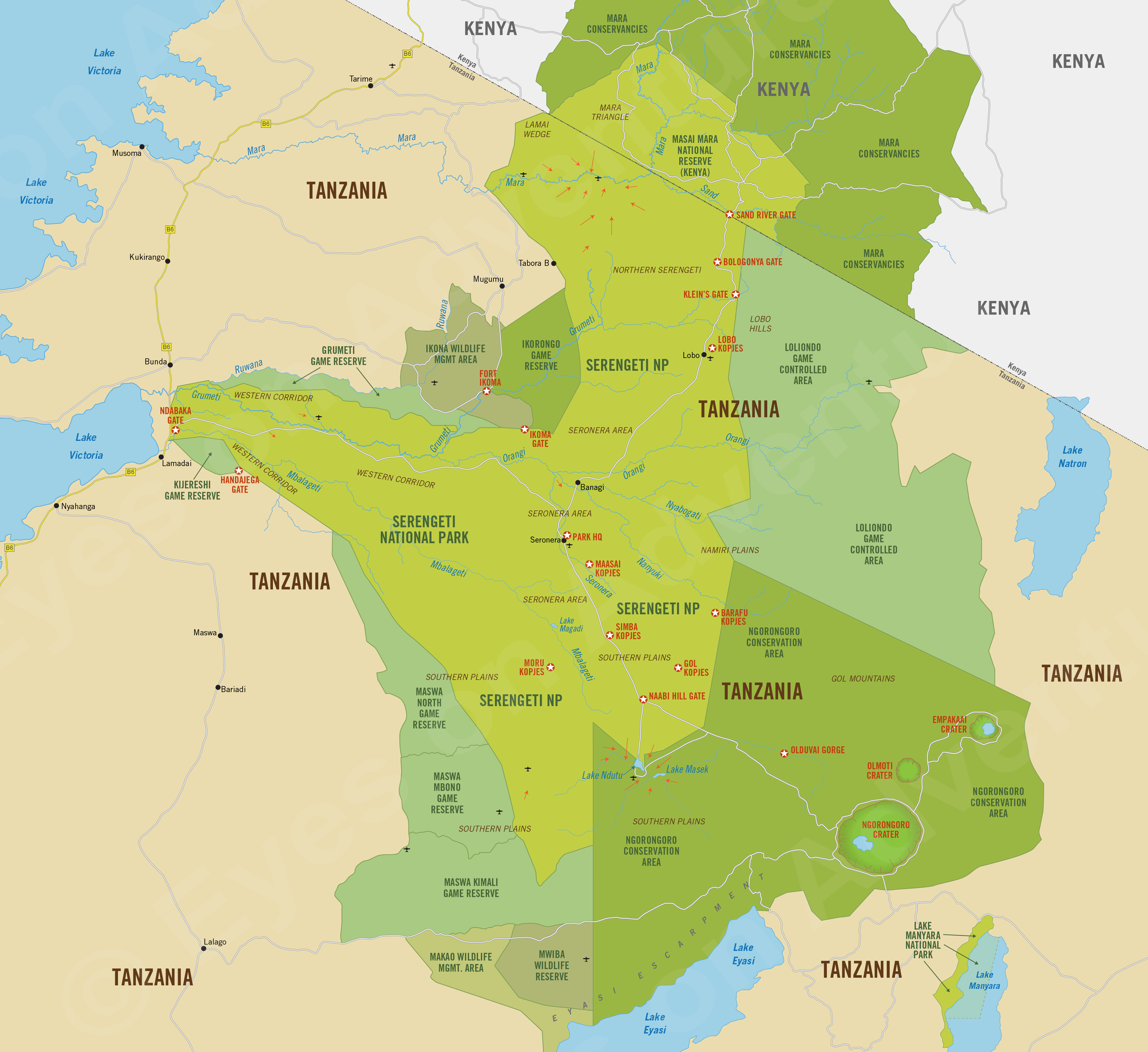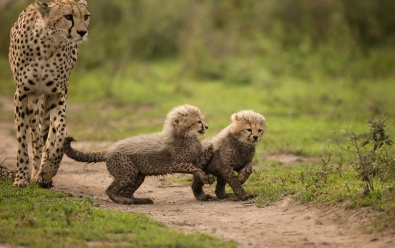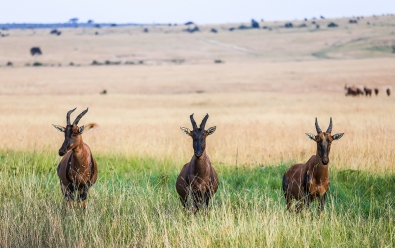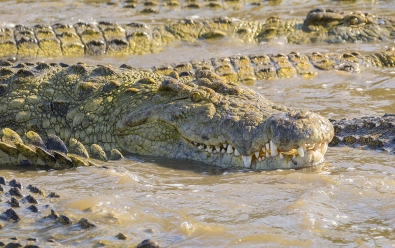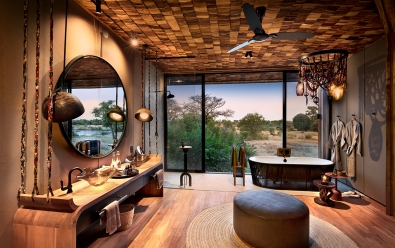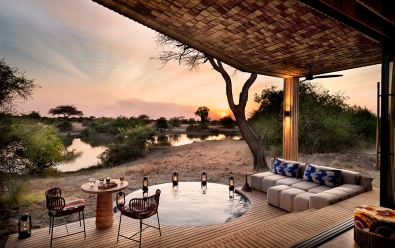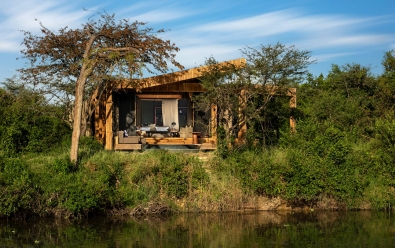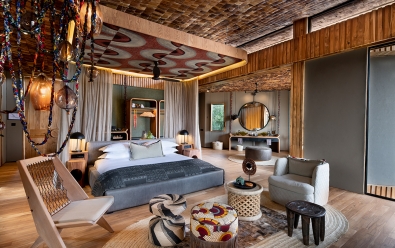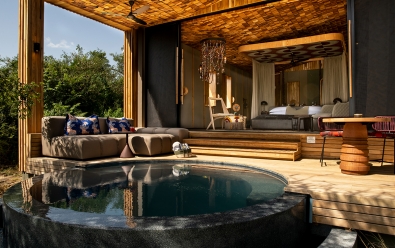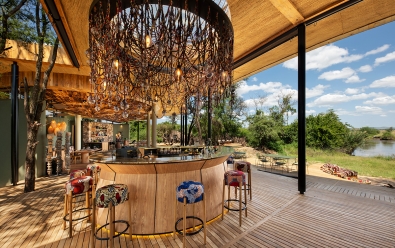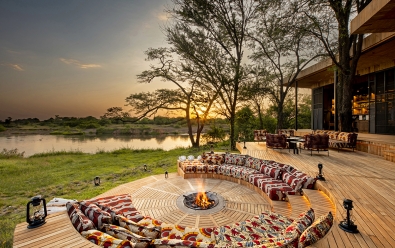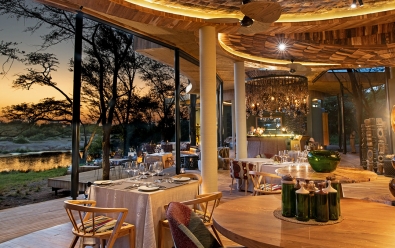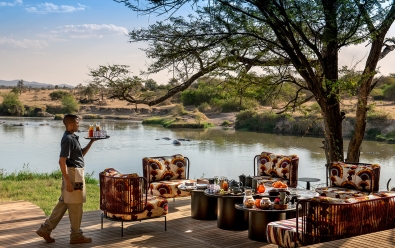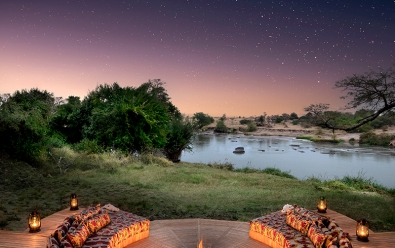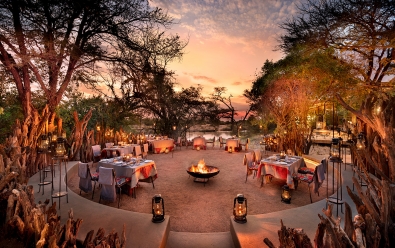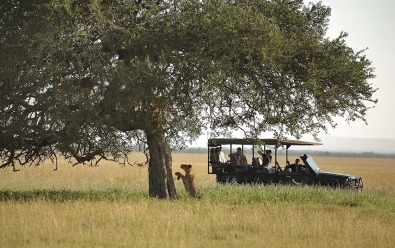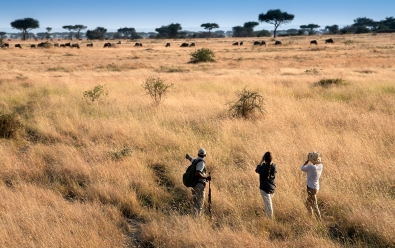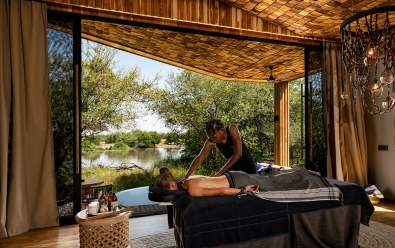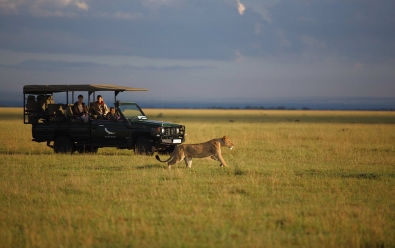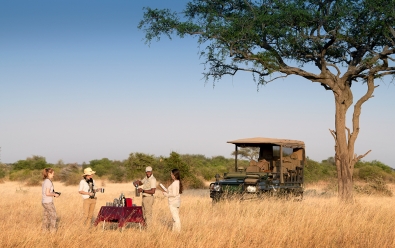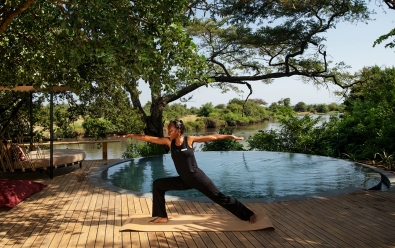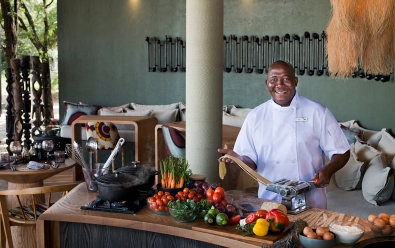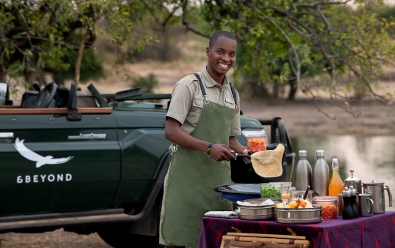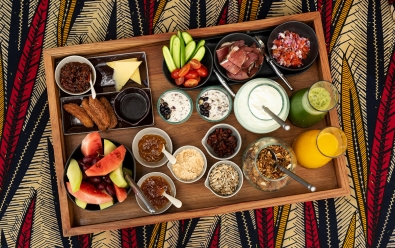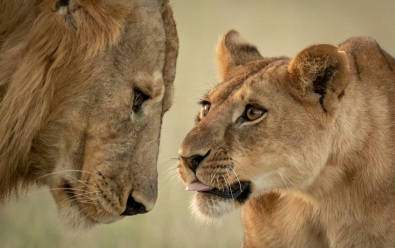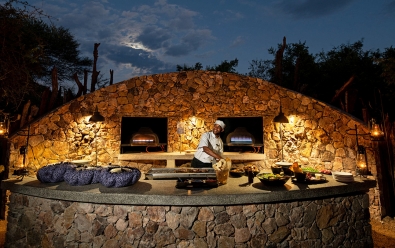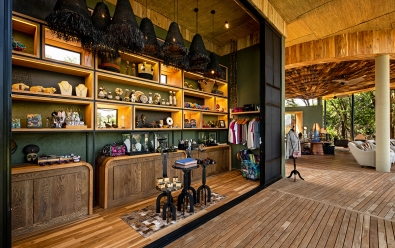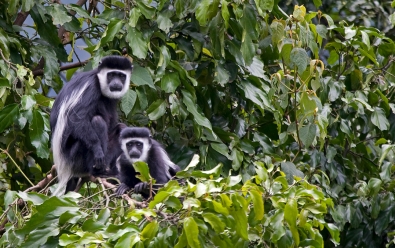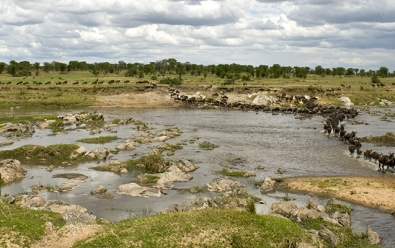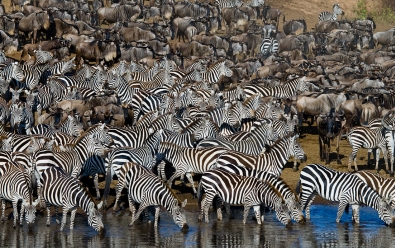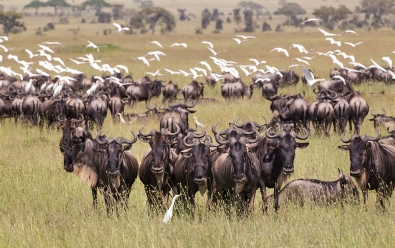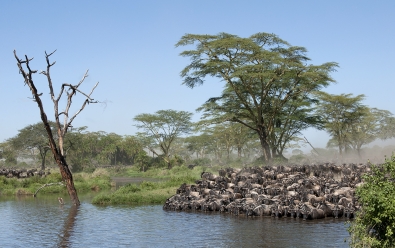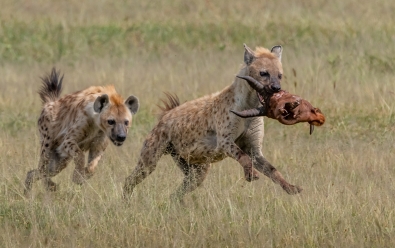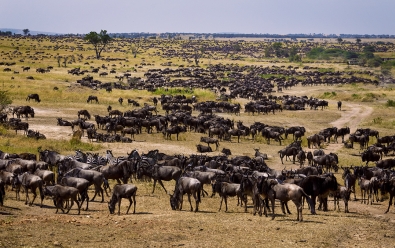Grumeti Serengeti River Lodge
Location
- Western Corridor
- Serengeti National Park
- Northern Tanzania
Located on the banks of a secluded river in the Western Serengeti, Grumeti Serengeti River Lodge offers year-round game viewing and a great location for viewing the annual Great Migration.
River Lodge is situated in the Serengeti's Western Corridor on the banks of the Kanyanja River, a seasonal tributary of the Grumeti River, which is located a short drive from the lodge. The Western Corridor is remote and has only a handful of safari lodges, which means fewer crowds and less vehicles, allowing for an exclusive experience.
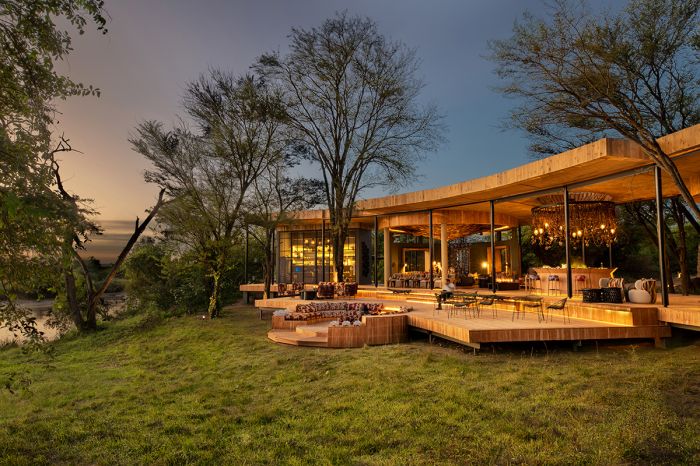
Grumeti Serengeti River Lodge's main guest area.
The lodge also sits on the route of the Great Migration of over two million herbivores (all of them zebras and wildebeests), which arrive in the area sometime in May and stay until continuing north sometime in July. Besides the Great Migration period, the western Serengeti is well-known for having excellent wildlife viewing all year, with plenty of resident plains game including buffalo, elephant giraffe, and topi, as well as predators, notably lion and spotted hyena.
This sector of the Serengeti is known for its large lion prides. There are several resident prides in the area and the lodge safari guides continuously monitor the lion numbers, so guests are assured excellent opportunities to see them. More often than not, guests will find themselves alone at a sighting, allowing ample time, as other vehicles are few and far between.
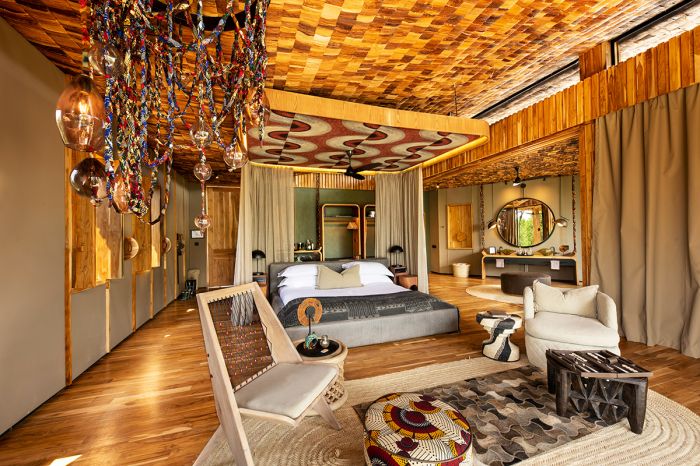
Guest suite interior at Grumeti Serengeti River Lodge.
Activities at River Lodge include twice-daily safari drives, nature walks with an expert guide, birding, hot-air ballooning, and cultural visits to one of the nearby local communities.
The lodge consists of 10 elegant and very spacious guest suites, one of which is a two-bedroom family suite. Each of the suites has an outdoor deck with a private plunge pool for relaxing during the midday hours between safari activities. The viewing decks and pools all have riverfront views for chances to see wildlife.
Walking into the lodge's guest area upon arrival is a real ‘wow’ moment. Spacious decks overlooking the river are ideal for enjoying meals, while the sparkling rim-flow swimming pool provides a view of the seasonal hippo pods below. The proximity to water draws a profusion of wildlife throughout the day and night.
The main area includes an indoor/outdoor lounge, dining area, and a dazzling bar. Situated closely are the traditional boma for outdoor dinners and a well-equipped gym. Healing Earth wellness treatments and yoga sessions are also on offer.
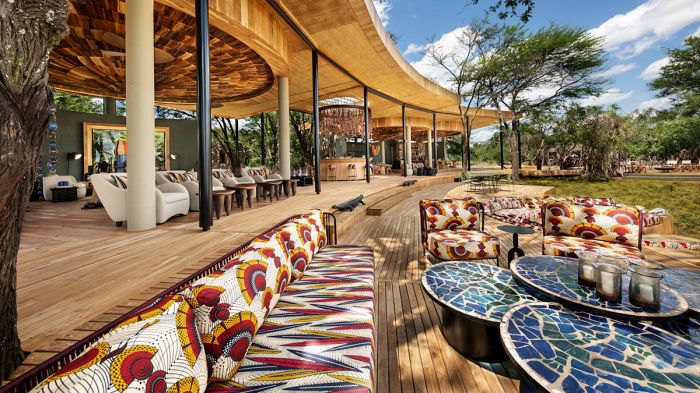
Main area indoor/outdoor lounge and deck at Grumeti Serengeti River Lodge.
AndBeyond are one of Africa's leading safari operators and they strive to minimize energy consumption at their camps and lodges. At River Lodge, a solar power system enables the lodge to run on 80% renewable energy. All back-of-house roof space (such as staff accommodation) has been used for solar panels.
Waste water from the laundry is recycled by an underground water-treatment system and used for activities such as the washing of safari vehicles. In addition, 2 600-gallon rainwater tanks support the filling of guest-suite plunge pools and the washing of the wooden decks. Strict eco-friendly environmental standards are maintained so that no harmful chemicals or waste is allowed to enter the pristine ecosystem of the Serengeti.
AndBeyond's 'Zero Plastic' initiative remains a consistent focus across their camps and lodges. Its 17 water-bottling plants have eliminated tens of thousands of plastic bottles (and counting) and translated into significant water savings. No heavy concrete foundations or slabs were used in the lodge's environmentally sensitive framework of lightweight steel clad in natural canvas, and sustainably sourced local hardwood.
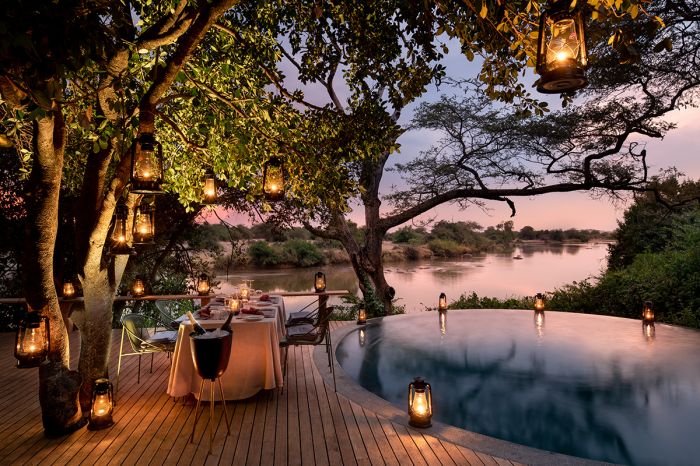
Dining on the pool deck with views to the river and a pod of hippos.
About the Serengeti
The Greater Serengeti is part of an extensive ecosystem that includes Serengeti National Park, the Ngorongoro Conservation Area, and other reserves, wildlife management areas, and game controlled areas.
The Greater Masai Mara (directly to the north in Kenya) includes the Masai Mara National Reserve, as well as numerous private Mara conservancies. Together, the combined Greater Serengeti-Mara ecosystem, which combines the areas described above, covers roughly 15 000 square miles (39 000 sq kms).
The Serengeti-Mara is home to a very large number and diversity of wild animals and is also the location of the well-known "Great Migration" of over 2 million herbivores (read more below). This is arguably Africa's greatest overall wildlife destination.
Wildlife densities in the Greater Serengeti are some of the highest in Africa, with commonly seen herbivores including blue wildebeest, plains zebra, Thomson's gazelle, topi, Grant's gazelle, hartebeest, giraffe, elephant, buffalo, impala, waterbuck, bushbuck, warthog, and many others. Predators seen often include lion, leopard, spotted hyena, cheetah, serval, and jackal. Hippo and crocodile are found in large numbers in the larger rivers, including the Mara River and the Grumeti River.
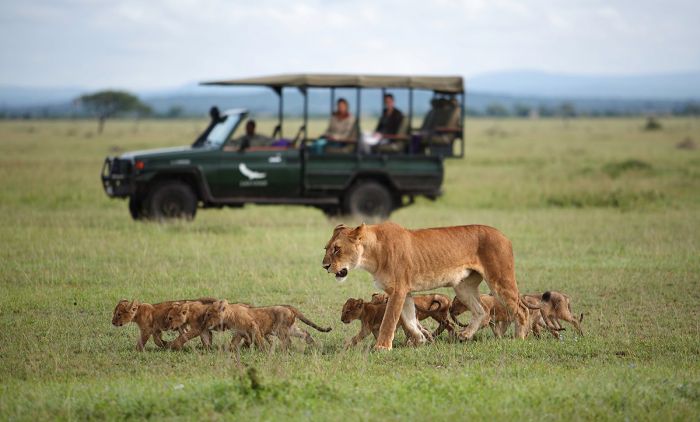
Lions seen on game drive at Grumeti Serengeti River Lodge.
ABOUT THE Western Corridor
The strip of land extending westward from Seronera (the central sector of Serengeti National Park) and reaching like an arm to within 5 miles (8 kms) of Lake Victoria is termed the Western Corridor. The Grumeti River is the key feature here, with forests and swamps lying to the north of the river and hilly grasslands to the south. This arm of land is much more densely vegetated than most of the park. The Mbalageti River also traverses the sector as it flows parallel to the Grumeti on its way to Lake Victoria.
The annual wildebeest and zebra migration typically arrives to the Western Corridor around May and remain in the area through July, before continuing north towards the Kenya border and eventually into the Masai Mara. Migratory crossings of the Grumeti River, usually occurring in June-July, are treacherous if the river is flowing, with hungry crocodiles that have waited up to nine months for the arrival of the herds.
Resident wildlife is good all year in the corridor, with giraffe, buffalo, topi, hartebeest, eland, impala, Thomson's gazelle, waterbuck, and non-migratory wildebeests and zebras. Predator sightings are good year-round, with an abundance of lions and leopards and even some cheetahs in the grassland area. Birding in the forests is superb and there is a population of black-and-white colobus monkeys as well.
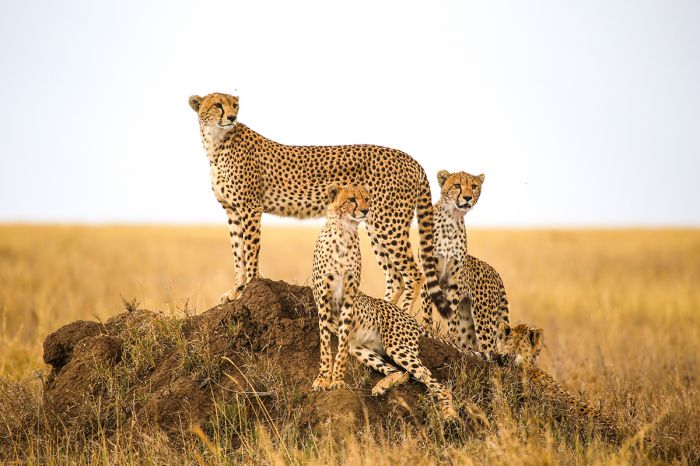
The Serengeti is one of the best places to see cheetahs.
The Great Migration
One of nature's greatest living spectacles is the Great Migration, a term given to describe the year-long, circular, clockwise march of over two million herbivores across the Serengeti and Masai Mara grasslands. The migration animals are made up entirely of two species: the blue wildebeest and the plains zebra (the majority of which are wildebeests).
The migrating herds follow their instincts to seek out fresh grazing and so the migration is ongoing, with the herds ever moving and taking a full year to complete a cycle across the Serengeti and Masai Mara. The animals move not as one herd, but as tens of thousands of animals in multiple herds of various sizes and spread out for many miles as they move.
The wildebeests and zebras take advantage of strongly seasonal conditions, spending the wet season (November through May) on the plains of Tanzania's Serengeti and the dry season in Kenya's Masai Mara. The wildebeests give birth between January and March on the short grass plains in the southern Serengeti.
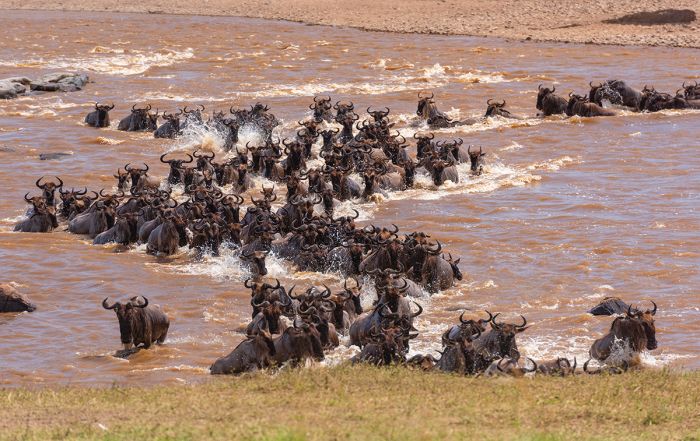
Wildebeests swimming across the Mara River in the Serengeti during the Great Migration.
The timing of the migration is rarely ever the same year-to-year, as local conditions influence grass growth and as such, the location of the bulk of there animals cannot be known precisely. Rains and other unknown conditions seem to direct the timing of the migration, but generally, it is known within several weeks when the animals will be in a general location.
The animals spread out to cover a vast area, but the main bulk of the animals moves south into the northern Serengeti around late-October and continue moving south towards the Serengeti's southern plains, arriving there sometime in January to graze on the rich grass growing on the volcanic soils. It is here on these short-grass plains, between January and early March, when the wildebeests give birth to their young en masse, producing some 500 000 baby wildebeests.
The herds remain on the southern short-grass plains until late March, giving the young animals time to grow and become strong, before heading north and west again. Many of the animals move towards the Serengeti's Western Corridor and Grumeti Reserve and the rest straight north into Central and Northern Serengeti, where they remain during June and into July. The herds move back into Kenya starting in late July, with the bulk moving into the Masai Mara in August.
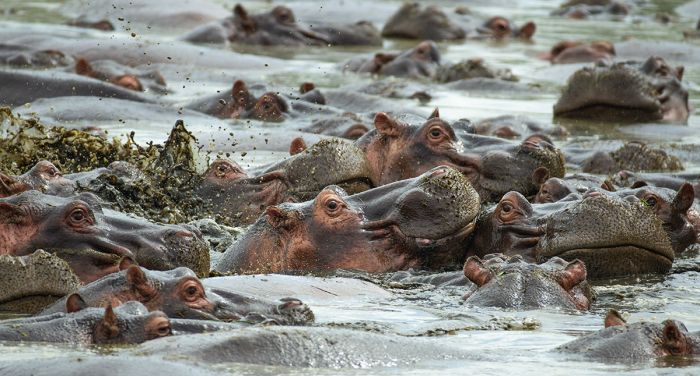
Hippos are found in the Serengeti's larger rivers, including the Mara and Grumeti, and seasonally in some of their smaller tributaries.
Although many visitors time their visit to the Serengeti to coincide with the Migration, any region within the Serengeti offers very good wildlife viewing outside of the months when the migration may be present. This is because it is only the wildebeests and zebras that migrate, while the rest of the animals, including the major predators like lion, leopard, spotted hyena, and cheetah, as well as all the other herbivores, including springbok, gazelles, elephant, topi, hartebeest, and many others, do not migrate.
A popular aspect of experiencing the Great Migration is observing a herd as it crosses the Mara River, which requires animals swimming through waters inhabited by large Nile crocodiles that wait for a chance to get their first substantial meal in many months.
The dramatic river crossings (which take place along the Mara River in both Kenya and Tanzania) are certainly a spectacle and not for the faint of heart, with many of the wildebeest and zebras taken by crocs or succumbing to drowning or trampling in the chaos. The best chances for seeing a Grumeti River crossing is in June, while Mara River crossings are best in July and August.
ROOMS INCLUDES & EXCLUDES CHILDREN FACILITIES ACTIVITIES
Accommodation
10 guest accommodations in total comprising:
- 9 spacious, wood and canvas suites, each with two three-quarter beds (separate mattresses with shared base). Mattress converters are available that transform the twin beds into a double bed (to be arranged prior to arrival).
- 1 family suite, consisting of two bedrooms, one of which is a smaller children's room. Each bedroom has its own en-suite facilities, the master having a double-basin vanity, indoor shower, bathtub, and separate toilet. The children's bathroom also has a single-basin vanity, shower, and toilet. An interleaving passage connects the two bedrooms. Outside is a large, private deck with a plunge pool overlooking the river. The family suite is the closest to the main guest area.
All of the guest suites are constructed on raised wooden decks and include en-suite facilities with a double-basin vanity, indoor shower, and separate toilet. The suites are accessed via footpaths on the ground leading to the main camp area.
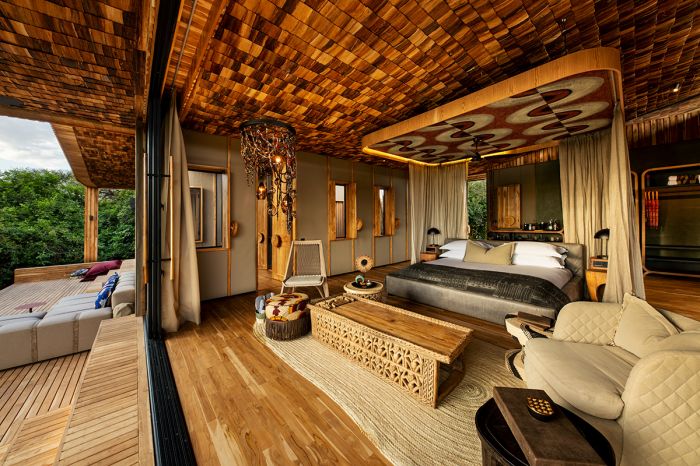
Family suite master bedroom and view onto the deck.
The guest suites are light, airy and generously proportioned and arranged along the natural bow of the Kanyanja River. The décor and furnishings are contemporary and authentically African. Ample natural light enters through large sliding doors and multiple windows. Despite the modern amenities, there is still the sense of being in an "under-canvas" safari-style tent, with the canvas walls and banana fibre ceilings.
The suites are comfortably-sized, covering 1 023 square feet (95 sq meters) inside and including the deck and pool, covering 1 400 square feet (130 sq meters). The larger family suite covers 1 442 square feet (134 sq meters) of indoor space and with the deck and pool, covers 2 100 square feet (195 sq meters). The distance between guest suites is 50 feet (15 meters).
Other items and features in the guest cottages include:
- Private veranda with plunge pool.
- Healing Earth treatments offered in-room.
- Private mini-bar and coffee station.
- Complimentary pair of Swarovski binoculars (one per suite).
- In-room Wi-Fi (also available in main guest area).
- Overhead fan.
- Mosquito netting over the beds.
- Hairdryer.
- In-room safe.
- JBL bluetooth music player.
Grumeti Serengeti River Lodge can accommodate a maximum of 23 guests in total: 2 persons in each of the 9 standard suites and a maximum of 5 persons (2 adults and 3 children) in the family suite.
Includes & Excludes
Includes:
- All meals and local beverages including soft drinks, house wines, local brand spirits and beers, teas, and coffees.
- Safari experiences (game drives, walking safaris, birding) accompanied by an experienced guide.
- Africa Foundation community visit.
- Guides' Journal with illustrations of fauna and flora to record your sightings.
- Area map with Grumeti's illustrated Star Birds checklist.
- Laundry services are provided on a daily basis (weather permitting, items will be returned on the same day). Laundry is dried by the sun and on most days any laundry placed out in the morning will be returned by the evening.
- A complimentary pair of Swarovski Optik CL Companion 8×30 binoculars per cottage/suite for use during your stay.
- Emergency medical evacuation insurance.
- Wi-Fi access.
- Tourism Levy & VAT.
Excludes:
- Hot-air ballooning.
- Purchases from the Safari Shop.
- Local community visits.
- Champagne, cognacs, fine wines, premium brand spirits, and cigars.
- Spa / wellness treatments.
- Private yoga sessions.
- Any applicable wildlife fee, park fee, reserve fee, concession fee, other land-use fee.
Single Supplement
A single supplement may apply for any room booked by a single traveler; please ask us for pricing.
Children
Families can rest assured that your children will always be safe and well cared for (both during activities and at the lodge) by the lodge staff.
Children of any age are accommodated at Grumeti Serengeti River Lodge:
- 1 triple available (in the family suite).
- Children under the age of 6 years are permitted only on a private vehicle or a children’s game drive (avoiding lion, leopard and elephants sightings), not during standard game drive time. No walks outside of the lodge.
- Children aged 6-11 years are permitted on game drives at the discretion of the manager and guides (private vehicle required).
- Children aged 6-11 years are not permitted on nature walks outside of the lodge grounds.
- Children aged 12-15 years are permitted on game drives (private vehicle required) and nature walks.
- Private vehicle not required for children aged 16 years and older.
- Children aged 16 and above are permitted on specialist walking safaris.
- Children that share a vehicle with other guests not in their party may be subject to activities only at the lodge manager’s discretion.
- Please note: The lodge is not fenced off and children are required to have an adult accompanying them at all times.
- While the lodge does not have trained child minders, it can offer the services of certain staff members who are wonderful with children. This will be at an additional cost (best to pre-book this with us).
AndBeyond’s WILDchild programme, designed especially for children aged 3-12 years, is filled with fun, interactive activities that offer opportunities to learn and discover new experiences and cultures. Deeply rooted in the love for the African bush, it not only creates a series of unforgettable moments for the whole family, but forges strong bonds between young guests, our planet, and its people.
Wildchild activities include:
- Tracking animal footprints with a guide in the lodge surrounds.
- Mouth-watering pizza making.
- Playing volleyball with the staff.
- Competitions to spot the elusive karamoja apalis, a local bird species.
- 'Beyond sightings' conservation research (for older children).
Facilities
Using the natural bow shape of the river, and paying homage to the circular forms of a traditional Maasai manyatta, the lodge unfolds to reveal an understated sense of luxury. Adorned with Kitenge fabrics and accentuated with stone walls, the lodge also features the vibrant colours of the fishing communities surrounding Lake Victoria and the grey tones representative of hippo hide that have been beautifully woven into deeply comfortable furnishings and bespoke, hand-made fittings.
Walking into the guest area upon arrival is a real ‘wow’ moment. Spacious decks are perfect for enjoying sundowners overlooking the river and the lodge’s sparkling rim-flow swimming pool provides a view of the seasonal hippo pods below. The proximity to water draws a profusion of wildlife throughout the day and night.
Main guest area facilities include:
- Bar, lounge and dining areas.
- Plunge pool and sundeck with loungers and views to the river.
- Traditional boma for outdoor dining nights.
- Interactive kitchen.
- Fully-equipped gym (yoga sessions offered).
- Safari Shop.
- Complimentary Wi-Fi access (also available in the guest suites).
- Guest toilets in main area.
Activities
Activities included in the rate:
- Morning and afternoon/evening game drives in open 4x4 Land Cruisers.
- A complimentary pair of Swarovski Optik CL Companion 8×30 binoculars per guest cottage for use during your stay.
- Guided one-hour nature walks.
- Birding.
- Back-of- house sustainability tour.
- Stargazing.
Optional activities at additional cost:
- Private activities are on offer (subject to vehicle availability, which needs to be booked in advance).
- Hot-air ballooning.
- Community visit to a local village.
- Wellness treatments (offered in-suite).
Example of a typical day:
- Early morning wake-up call. Morning wake-up and activity times vary according to the seasons, activities on offer, and wildlife sightings.
- Light breakfast before departing on the morning activity.
- Return to the lodge for a meal and rest period.
- Meet for afternoon tea and snacks (savory and sweet choices) before departing on the activity.
- Return to camp - freshen up or meet for drinks, followed by dinner.
- Enjoy a nightcap and/or discussion at the bar or around the campfire before retiring.
Great Good Fair Poor
- Jan
- Feb
- Mar
- Apr
- May
- Jun
- Jul
- Aug
- Sep
- Oct
- Nov
- Dec
General Tips
It is advised to avoid the Serengeti over March and April, when heavy rains typically occur. June to mid-October is excellent for general game viewing. The large herds of animals in the Great Migration usually cross into the Serengeti from Kenya's Masai Mara sometime around early October and move north back into Kenya around mid- to late-July.
Besides the Great Migration, the other big factor that impacts a stay in the Serengeti is rains. The region experiences most of its rain between November and May, but there are two somewhat distinct rain seasons, the 'short' rains and the 'long' rains (read more below).
Grumeti Serengeti River Lodge is open all year except for the month of April.
Rains
Short Rains
The short rains occur for about one month sometime during November and December (the exact time varied somewhat year to year). This period is called the 'short' rains because the duration of an individual rain event is short and it is rare to have an all-day rain event. Most rain falls as an afternoon shower, while mornings are typically overcast or clear.
Long Rains
The long rains occur between March and May, with April being the wettest month of the year. During this tome, rain should be expected almost every day and the showers can last for hours at a time, although all-day rain is not typical. The roads in the Serengeti become muddy and very difficult in places, which can hamper game drives. Cloudy skies are typical and temperatures can be chilly at times.
The period between the short and long rains (January and February) also receives rain, but many days are clear and the amount and duration of the rain events is unpredictable, with some afternoon showers and the odd long and heavy rainfall event.
Temperatures
The temperatures in the Greater Serengeti do not experience wide fluctuation throughout the year, as the region lies between one and three degrees south of the equator. In general, daytime temperatures are comfortably warm and overnights and early mornings are chilly. Bring a fleece and rain jacket regardless of the timing of your visit.
Dry Season
The dry season (June to October) is sunny and warm most days and rarely hot. Rare rain showers can occur but are unlikely. From June thru August, the afternoon temperature averages 76-78°F (24-25°C), but some days can be warmer. Evenings and early mornings temperatures are often chilly, averaging 53-55°F (12-13°C).
September and October days are very pleasant, with temperatures averaging 80-83°F (28-30°C), with cool mornings persisting, averaging 53-56°F (11-13°C).
Rainy Season
The rain season is November through May (read more above) and the temperatures are fairly static throughout the season. Daytime temperatures average 79-83°F (26-28°C) and nighttime and early morning temperatures are chilly, but slightly warmer than the dry season, averaging 54-57°F (12-14°C)
The Great Migration
The annual movement of wildebeest and zebras across the Serengeti-Mara ecosystem is one of the greatest spectacles in the natural world. These large herds move in a circular track across southern Kenya and northern Tanzania, taking a full year to complete their cycle. The migration moves across both the Greater Masai Mara (in Kenya) and the Greater Serengeti (in Tanzania) in a fairly consistent pattern and timeframe. The animals move to take advantage of fresh grasses on which to graze.
The migrating herds of roughly 1.5 million blue wildebeests and several hundred thousand plains zebras spend about nine months of the year moving through Tanzania's Greater Serengeti and the other three months in Kenya's Greater Masai Mara. The migrating herds are in Tanzania's Greater Serengeti from sometime in October until around late-July (note that the timing is never precise and varies somewhat year to year). Note that the Serengeti is vast, and it is important to note where in the region the herds are located during this nine-month timeframe.
The animals spread out to cover a vast area, but the main bulk of the animals moves south into the northern Serengeti around late-October and continue moving south towards the Serengeti's southern plains, arriving there sometime in January to graze on the rich grass growing on the volcanic soils. It is here on these short-grass plains, between January and early March, when the wildebeests give birth to their young en masse, producing some 500 000 baby wildebeests.
The herds remain on the southern short-grass plains until late March, giving the young animals time to grow and become strong, before heading north and west again. Many of the animals move towards the Serengeti's Western Corridor and Grumeti Reserve and the rest straight north into Central and Northern Serengeti, where they remain during June and into July. The herds move back into Kenya starting in late July, with the bulk moving into the Masai Mara in August.
The migration is rarely ever the same in terms of precise timing and direction, as local rains and other conditions influence grass growth. The wildebeest may, therefore, move off the open plains earlier in some years and remain in the northern Serengeti for longer in others. Nonetheless, the best months for seeing the migration in the Southern Serengeti are in February and March, when the herds are adding new babies, in the Central Serengeti during May and June, when the herds are the most concentrated, and in the Western Corridor, Grumeti, and far Northern Serengeti from June thru August.
Many visitors hope to witness dramatic river crossings, when hungry crocodiles attack the herds as they swim across the dangerous rivers of the Northern Serengeti. Like the migration in general, the precise timing of the river crossings is never known from year to year, but crossings on the Grumeti River are usually best in June, while Mara River crossings are best in July and August.




